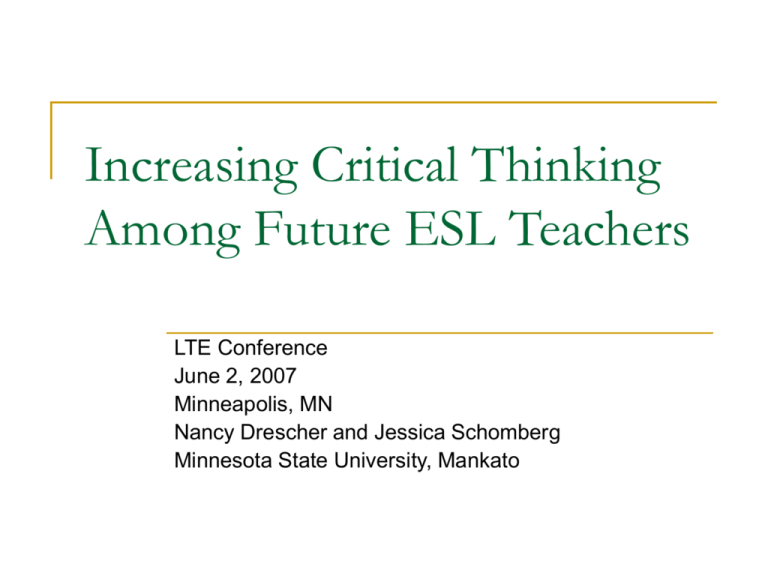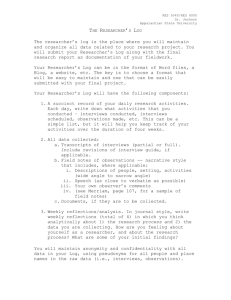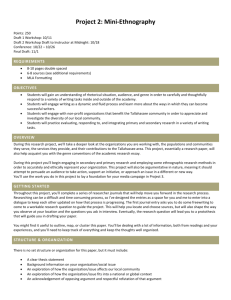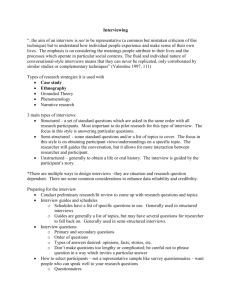Increasing Critical Thinking Among Future ESL Teachers
advertisement

Increasing Critical Thinking Among Future ESL Teachers LTE Conference June 2, 2007 Minneapolis, MN Nancy Drescher and Jessica Schomberg Minnesota State University, Mankato Overview Context of the Research Explanation of Select Activities Researchers Methods Course Framework for Critical Thinking Problem Solving Scenario Research Project Unit Plan Quizzes Self Assessment Results/Discussion we should be wary of embracing any of these ideas wholesale and assuming that by implementing them we absolve ourselves of responsibility for further critical thought and decision-making. Above all, we should be careful not to assume that one set of recipes will work for all learners, all teachers, all contexts (Bowen and Marks, 1994, p. 12). Critical Thinking (www.criticalthinking.org) Critical thinking is the art of taking control of one’s thinking. Critical thinking means continually bringing thinking to the conscious level assessing it, identifying it’s flaws, and then reconstructing it. Problem solving scenario An ESL teacher works in 4 different schools, etc. The problem: she needs to connect with the larger community of ESL teachers but rarely has any scheduled time to meet with the teachers she wants to ‘conduct research’ but barely has time to plan her classes. she doesn’t have time to build relationships; on most days she spends her lunch hour driving from one building to the next, eating her lunch on the road. she is not keeping up to date with her teaching, but she doesn’t know how to make time to go to conferences or read enough articles/books. She doesn’t even really know where to look for articles and books. She spends so much time working that she is neglecting her family and doesn’t want to take any more time away from them. She thinks that if she doesn’t change things, she will soon be drained and have to switch careers even though she loves her students and can’t imagine doing anything else. Argument Mapping When I was making an argument map, it forced me not only to organize my thoughts and reasons, but also to organize what her problems and concerns are. Sometimes, when I argue, I tend to think the issue as my issue. However, when I look at the map, I could see what MARY wants, rather than what I want. Research Project 3 choices for project (action research, case study, clinical option) Used Elements of Reasoning Wheel to examine thinking prior to research Critical Thinking Approach to Conducting Interviews (practice) Increased input on how to locate, obtain, and critically evaluate research Critical Thinking Wheel “it helped me to understand the things I have to include in my research process and research question.” “It was a great way for me to be able to see where I was at in forming my project and what I needed to plan better. It helped me a lot in forming how I thought about the project and comparing it to others and what approach they were taking to the project.” “It was a good visual aid and a guide for thinking …. It made me think of things that I normally wouldn’t have thought of...” state the interview's purpose research the topic select interviews structure the interview conduct the interview prepare the report (www.criticalthinking.org) Practice Interviewing Stage 1 in the information interview is determining the purpose. Read the interview below. What could the researcher say in the beginning to clarify the purpose? How does the project manager contribute to the confusion? What would you do differently as interviewer? Interviewee? Researcher: So you're a project manager here at High Tech Corp.? Project Manager: Yes. Researcher: I'm here to ask you some questions about what you do here. Project Manager: Okay. (Looks at watch.) Researcher: Let me set my tape recorder on your desk. Where's the nearest outlet? Project Manager: You're taping this interview? Researcher: Yeah, I tape all my interviews. I already cleared it with your supervisor. Project Manager: Oh, okay. Researcher: First question: What do you do here? Project Manager: I'm the project manager for high-end website development. Library Research Library catalog Library databases (ERIC, LLBA) Websites (NetTrekker, Educator’s Reference Desk) How to evaluate research articles, websites, etc. Purpose of student’s research Purpose of writer/publisher Currency of research Register (scholarly) Bibliography Troubleshooting Library Research this class has really helped me find and evaluate resources that I find on the Internet. Prior to this class, I would have used just about any resource I could find on the Internet for a project. Now I understand that you have to look at the resource and find out how valid the information or research is in it before using it. Unit Plan Create a Unit Plan for a specific group of Language Learners that includes specific focus on increasing their critical thinking in addition to a clearly organized content driven unit of study Unit Plan In terms of the unit plan: “Most of our objectives and goals focused on the critical thinking wheel, asking the questions and being to answer them within the framework of our unit plan. As it progressed, it became an incredible learning experience to be able to coordinate our separate viewpoints, to organize our lesson plans and most important, to create a meaningful and effective unit plan structure which was relevant.” On many occasions while writing the unit plan, my brain hurt from trying to manage all the different pieces that were involved. I think that this stress is / was a good indicator that the critical thinking process was taking place. During the process, we also had to re-evaluate our goals and adapt our assignments and our lessons to suit these goals. Bloom’s Taxonomy Student Comment My unit plan group tried to use critical thinking skills in our lesson plans because we know that that’s the most important thing we can teach our students. We don’t want them to just measure a bunch of facts about the content; we want them to be able to think critically about it! Quizzes Included hypothetical situations and case studies I am getting the most critical thinking practice in completing the quizzes. I try to answer the questions by considering all different facets of the question. These quizzes force me to address the problem from a holistic perspective and explore how the broader solution still needs explanation for how it can be applied on a smaller (micro) level. And Some Just Missed the Whole Point it is very possible that I have no idea what critical thinking is. It is evaluating and judging, right?... I didn’t understand the “thinking wheel” and would not know how to apply it to a class. I think the main problem with that activity was that the purpose of the activity was not very clear. I remember it as being something along the lines of use critical thinking to come up with a topic for your research project. Anyway, that was lost on me because I thought the purpose of the observation was to observe. So right away I was like, “What do I need to figure out here? I want to see how you teach adult ESL students. I did not use the critical thinking wheel, mapping exercise, or Bloom’s taxonomy. I did not feel that I needed to use the above activities to help me think critically. I feel that I already have a good grasp on that and therefore did not need to use the above as references. Conclusions The activities did increase students attention to their own thinking in many instances. The increased attention to critical thinking helped many students produce higher quality work Better resources More focused research projects/clinical experiences Increased focus on critical thinking and higher level processes for unit plans and quiz responses A very few students seemed unengaged from beginning to end. Producing mediocre work and seeing no point in thinking critically. They wanted the recipe.








